#ashy wren-warbler
Text
Ashy Prinia:
The ashy prinia (Prinia socialis) is a small passerine bird belonging to the prinia family, Cisticolidae. It is also known as the ashy wren-warbler or ashy warbler. Here's some information about the ashy prinia bird.

Appearance: The ashy prinia is a small bird, measuring around 12 to 14 centimeters (4.7 to 5.5 inches) in length. It has a slender body with a long, graduated tail. The upperparts are primarily ashy-gray, while the underparts are pale grayish-white. It has a relatively short bill, a dark eye, and pale legs.
Distribution: The ashy prinia is native to South Asia and can be found in various countries including India, Nepal, Sri Lanka, Bangladesh, Bhutan, and parts of Myanmar. It typically inhabits grasslands, scrublands, and open areas with tall grass or reeds.

Behavior and Diet: Ashy prinias are active and agile birds. They are known for their characteristic tail-wagging behavior, where they constantly move their tails up and down. They feed mainly on insects, foraging among vegetation and occasionally making short flights to catch prey. Their diet may also include spiders, small invertebrates, and seeds.
Breeding: During the breeding season, which varies across its range, the male ashy prinia establishes a territory and sings to attract a mate. The female constructs a cup-shaped nest using grass, leaves, and other plant materials, typically placed in low bushes or tall grasses. The female lays a clutch of 3 to 4 eggs, which she incubates for about 12 to 14 days. Both parents contribute to feeding the chicks until they fledge.
Vocalization: The ashy prinia is known for its varied and melodious song, consisting of a series of whistling, trilling, and warbling notes. Their vocalizations are an important means of communication within their territories.
Conservation Status: The ashy prinia is not globally threatened and is listed as a species of "Least Concern" by the International Union for Conservation of Nature (IUCN). However, like many bird species, it may face localized threats due to habitat loss and degradation.
The ashy prinia is a delightful bird to observe, known for its lively behavior and pleasant song. Birdwatchers and nature enthusiasts often enjoy encountering these charming little birds in their natural habitats.
Download copyrights free stock photos @shutterstock
Sell your stock photos @shutterstockContributor
#photography#photographers on tumblr#ashyprinia#passerinebirds#smallbirds#warbler#birdlovers#ornithology#nature#greenery#trees#forest#nature photography#bird photography#birding#birdwatching#birds nature
1 note
·
View note
Photo

#ashy prinia#ashy wren-warbler#warbler#prinia#birds#small birds#colors#Indian birds#Indian aves#aves#nallagandla#nallagandla lake
5 notes
·
View notes
Photo

February 28, 2017 - Ashy Prinia or Ashy Wren-warbler (Prinia socialis)
These birds are found in much of South Asia, in parts of India, Pakistan, Nepal, Bhutan, Bangladesh, Sri Lanka, and western Myanmar. They eat mostly insects and their larvae, along with small spiders and occasionally nectar. Building nests from various grasses, or several leaves stitched together and lined with hair, both parents care for the chicks. They are said to make a distinctive snapping sound during flight, which may be produced by their feathers, though the source of the sound has not been definitively determined.
#ashy prinia#prinia#ashy wren-warbler#prinia socialis#bird#birds#illustration#art#grassland#birblr art
61 notes
·
View notes
Photo
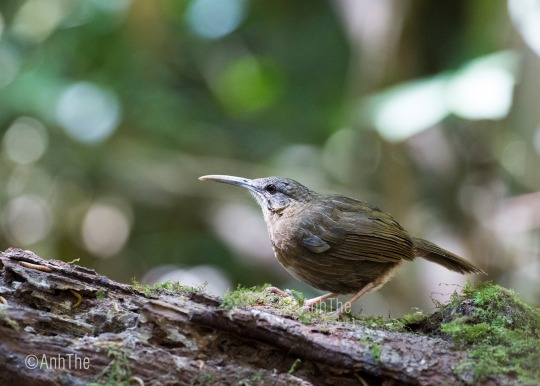
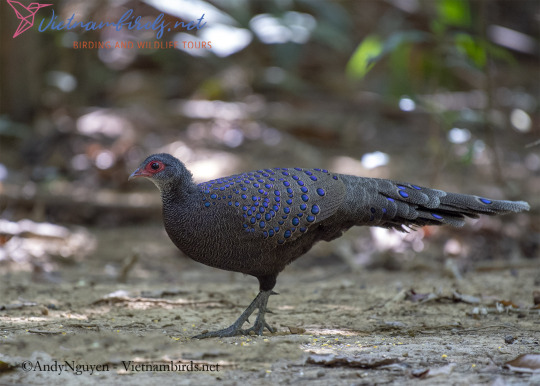
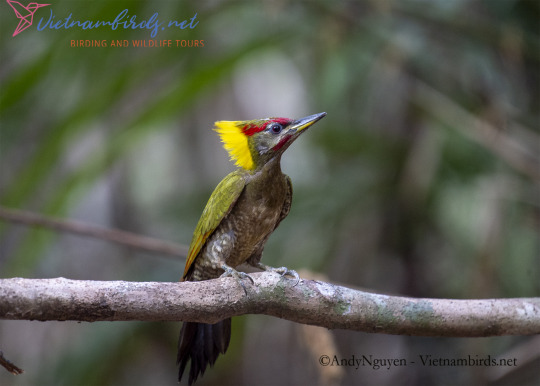
Best Bird Watching Trail in Vietnam
Birding tours to Vietnam – Day 1 : Ho Chi Minh City – Cat tien National Park
Guide will meet you at the hotel at 6:00 am (you will confirm exactly hotel name) then go directly to Cat Tien National Park, arrive to Cat Tien after 3.5 hour on car, after check-in time, we will go to find some birds along the main road in side Cat tien NP.
With the main roads 3km, you can see some kind of bird Cat Tien: Drongos, leafbird, tailorbird, warbler, Grey-faced Tit-babbler, Pin-striped Tit-babbler, Sunbirds, Banded kingfisher, Square-taied Drongo-cuckoo, Thick-billed Green-pigeon, Orange-breasted trogon, Woodpeckers,…
Accommodation: The Guess house inside of National park with the best room (Double room with air-condition, hot shower, free WIFI), as pictures attach below.
Meals: Breakfast on the way to Cat Tien, you will surprise about “Pho” (Vietnamese noodle with beef or chicken ), Lunch and dinner at the Tre vang restaurant inside of National park. That restaurant have menu open with Europian style or Asia style.
Day 2: Cat Tien National park – First Ideal Location for Birding Tours to Vietnam
We start at 6:00 to the restaurant for breakfast and then go to birding for highlight targets in Cat Tien : Bar-bellied Pitta, Blue-rumped Pitta, Germain’s peacock pheasant, Siamese fireback, Green-legged Partridge… in the bird-hide tent. More ever you can see some kinds of bulbul group, babbler group, warbler group, woodpeckers group …
After Dinner , we go to find some Owls : Asian barred Owlet, Brown hawk owl, Collared Scops Owl, Large-tailed nighjar.
Accommodation: At the same room
Meals: B/L/D : at the restaurant same with the first day.
Day 3: Cat Tien to Da lat City
We will leave at 6:00 am to be the first to arrive in the grasslands. This short tour will give you the experience of seeing and photographing Green peafowl, Red junglefowl, Imperial pigeon and many beautiful birds that appear early in the morning in the grasslands.
Moreover, there are many species of herbivores that also appear: sambar deer, red muntjak, wild boar, … if lucky, you can meet Gaurs.
After lunch , check out at 1:00 and moving to Da lat City, we arrive after 3 hours transport (after 17:00pm).
Accommodation in Dream Hotel – Phan Dinh Phung Street, Dalat City.
Dream Hotel is a mid-range hotel (2 stars) in Dalat. However, this is a hotel with more than 20 years serving birds, very experienced senior understand and serve the discerning birder. They have a breakfast from 5:00 am serving a variety of European and Asian styles.
There are many other accommodation options, in the more luxurious and central hotels, but serving breakfast at 5:00 am is not possible, which is very inconvenient for birders.
Day 4: Da Lat City – Bidoup Nuiba National Park
Breakfast at 5:30 and then we go directly to Bidoup Nuiba National park. Full-day for bird watching in Giang Ly and Hon Giao area. In this place, we have 3 bird-hide for us with some high-light target : Collared laughingthrush (endemic), Black-hooded laughingthrush, White-cheeked Laughingthrush, Grey-bellied Tesia, White-browed Scimitar Babbler, Rufous-throated Partridge, Black-crowned Fulvetta (endemic), Pygmy Cupwing, Large Niltava, White-tailed Robin, Snowy-browed Flycatcher, Orange-headed Thrush…
In addition, We will follow the streams along the stream, there will be many moments when there will be many birds living along the stream to take pictures: Spotted Forktail, Slaty-backed Forktail,Plumbeus Water Redstar, Blyth’s Kingfisher, Common Kingfisher.
We will move back to the hotel in Dalat city at 17:30pm.
Accommodation: at the Dream Hotel.
Meals: B at the Dream hotel restaurant
L at the restaurant near birding hide
D: Restaurant in Da lat City.
Day 5: Bidoup Nui ba National Park – Second Ideal Location for Birding Tours to Vietnam
We continute birding in Bidoup Nui Ba national park in another place with some special birds : Rusty-naped Pitta, Orange-breasted laughingthrush,
Vietnamese Greenfinch, Red-crossbill, Vietnamese Cutia, Yellow-cheeked Tit, Green-backed Tit, Chestnut vented Nuthatch…
Nigh time for: Going to Da Lat night market.
Day 6: Dalat City – Di Linh Plateau
Early morning to go to Hoa Son Dien Trang for endemic : Grey-crowned Crocias, and more rare birds : Rufous-backed Sibia, Black-headed Sibia, Bay Woodpecker, Speckled Piculet…
Then enjoy lunch time in Datanla Water Fall for: Vietnamese Cutia, Annam Barbets, Mrs Gould’s Sunbird, Langbian Sunbirds…
We will leave Da Lat at 17:00 and go to Di Linh, to Di Linh at 18:30 and stay at Thuy Duong hotel.
Day 7 : Di Linh Plateau: Deo Nui San – Third Ideal Location for Birding Tours to Vietnam
Full-day birding in Deo Nui San hot-spot, with 2 bird-hide, we can enjoy with more than 25 birds species in nice picture :
Target birds: Indochinese Green-magpie, Black-headed Parrotbill, Silver-breasted Broadbill, Bar-backed Partridge, Large Scimitar Babbler, Red-billed Scimitar Babbler.
Other birds: White-throated Rock-thrush, Siberian Thrush, Blue-throated Blue-flycatcher, Orange-headed Thrush, Buff-breasted Babbler, Grey-throated Babbler, Puff-throated Bulbul, Ashy Bulbul, White-bellied Erpornis,…
Day 8: Di Linh – Ho Chi Minh City – Flight to Pleiku City
The morning bird photography at Nui San Pass. Another bird-hide for : Blue Pitta, bar-backed patridge, Streak-wren Babbler…
We will leave Di Linh to return to Ho Chi Minh City after lunch. We will fly straight from Ho Chi Minh City to Pleiku City in the evening flight, to Pleiku City and travel by car at night in Kontum City, 40km from the airport.
Day 9: Kontum province – Mang Den town – Forth Ideal Location for Birding Tours to Vietnam
Departing at 6:00 from Kontum to Mang Den town, With 60km road we will take an hour by car.
The whole day will be looking for birds in Mang Mang, the goal is : Chestnut-eared Laugingthrush.
More : Sultant Tits, Racket-tailed Treepie, Long-tailed Shrike, Crested Serpent Eagle, Stripe-breasted Woodpecker, Grey-cheeked Warbler…
Day 10: Mang Den town to Ngoc Linh Nature Reserve
Continue a full morning for bird watching in Mang Den. We will leave Mang Den after to move to Tumorong town, Arrive at hotel at 19:00.
Tumorong is a very remote town in the northern highlands of Vietnam, bordering Laos and Cambodia.
Day 11: Ngoc Linh Nature Reserve – Fifth Ideal Location for Birding Tours to Vietnam
We will birding and bird photography at Ngoc Linh Nature Reserve, After more than 1 hour moving from the hotel to the core of the Nature Reserve, where there are bird-hide we have set. You will find it interesting because the birds are so beautiful, many species come to bird-hide so you can take photos of the day. Some goals such as: Red-tailed Laughingthrush, Golden-winged Laughingthrush (endemic), Coral-billed Scimitar-babbler, Rufous-winged Fulvetta, Rusty-capped Fulvetta, Grey-bellied Tesia, …
Day 12: Ngoc Linh NR to Da Nang City
Continue a full morning watching and taking photos of birds at Ngoc Linh Nature Reserve, with the goals not to be missed such as: Black-crowned Barwing, Black-headed Sibia, Golden-breasted Fulvetta, Indochinese Fulvetta, Green-tailed Sunbirds …
We will leave Ngoc Linh Nature Reserve after lunch time, and travel by car to Da Nang city, the 230km square will take 5 hours to move.
Overnight at Brilliant Majectic Hotel Danang.
Day 13: Da Nang city – Bach Ma National Park – Sixth Ideal Location for Birding Tours to Vietnam
We start early at 5:30am and arrive to Bach Ma NP at 7:30am for birding allday in Bach Ma, that place have no bird hide so we only walk along the main road and some trails in the park. We rest in Phong Lan villa on the top of Bach Ma NP. After dinner, we will herping and spotlighting mammals to 23:00pm., Special we will discover some “Vietcong tunnel” on the top of Bach Ma in nighttime, have Bats insite !
Accommodation : B at Da Nang city; L, D at Phong Lan restaurant.
Day 14: Bach Ma National Park to Khe Sanh town
Birding all day and herping in nocturnal ,
Accommodation : B, L, D at Phong Lan restaurant.
Room : Phong Lan Villa on the top of Bach Ma
Day 15: Birding in Sa Mu Pass and go to PhongNha KeBang National Park
After birding and breakfast on the top of Bach Ma, we check-out at 11:00 am and go to Phong Nha Ke Bang National park , On the way, we have 1 day in Sa Mu Pass, the new destination in the Middle of Viet Nam, for some rare birds : Collared Babbler, Rufous cheeked Laughingthrush , and on the trails we can fine some diurnal snakes…
We arrive Khe Sanh town at 16:00 pm and check in
Day 16: PhongNha KeBang National Park
In the afternoon we will go to Phong Nha Ke Bang National park ,
We will checkin the Park’s hotel at 18:00pm and prepare for Herping to 23:00pm
Birding tours to Vietnam – Last day – Day 17: PhongNha KeBang National Park to Dong Hoi Airport, Back to Hochiminh City
In this park we can see Ha tinh Langur (one of the rarest primates in Vietnam and on the world ) , Anyway we can see some interesting birds : Red-collared Woodpecker , Sooty babbler, Red-headed Trogonand on the trails we can fine some diurnal snakes in the morning and check out, we will go to Dong Hoi airport (60km from the park) and fly to Ho chi minh City (Fly Depart at 20:00 pm)Arrive to your hotel in HCM City at the midnight.
More Bird Watching Trails in Vietnam: https://vietnambirds.net/top-bird-watching-trails-in-vietnam-you-should-spend-your-holiday/
9 notes
·
View notes
Photo

Description DescriptionThe ashy prinia or ashy wren-warbler is a small warbler in the family Cisticolidae. This prinia is a resident breeder in the Indian Subcontinent, ranging across most of India, Nepal, Bangladesh, Bhutan, Sri Lanka and western Myanmar #birds #birdsofinstagram #birds_adored #birds_captures #birding #birdingphotography #birdingdaily #birding_photography #birdinginnature #nature #naturephotography #naturelovers #nature_perfection #nature_brilliance #canonphotography (at Gurgaon, Haryana) https://www.instagram.com/p/B6mMZ_OnJFP/?igshid=wwxyrl00jwf1
#birds#birdsofinstagram#birds_adored#birds_captures#birding#birdingphotography#birdingdaily#birding_photography#birdinginnature#nature#naturephotography#naturelovers#nature_perfection#nature_brilliance#canonphotography
10 notes
·
View notes
Photo

The ashy prinia or ashy wren-warbler (Prinia socialis) on a Mulberry Tree alongside road. This short clip film on my mobile phone camera during my morning walk with my dog. More Information: The ashy prinia or ashy wren-warbler (Prinia socialis) is a small warbler in the family Cisticolidae. This prinia is a resident breeder in the Indian Subcontinent, ranging across most of India, Nepal, Bangladesh, Bhutan, Sri Lanka and western Myanmar. It is a common bird in urban gardens and farmland in many parts of India and its small size, distinctive colours and upright tail make it easy to identify. The northern populations have a rufous rump and back and have a distinct breeding and non-breeding plumage while other populations lack such variation. #parinia #ashyprinia #ashywrenwarbler #priniasocialis #warbler #smallwarbler #cisticolidae #cisticolidaefamily #birds #bird #commonbirds #birdlife #birdsofindia #birdsofpunjab #birdsofindiansubcontinent #birdphotographersofindia #indianbirdsphotography #birdlovers #birdwatching #birdwatchers #birdphotography #naturephotography #nature #wildlife #wildlifephotography #tarlokkumarphotography #birds_adored #birding #bird_brilliance #birdfreaks (at Jalandhar, India) https://www.instagram.com/p/COPA4eWg45-/?igshid=8yamh30hhbkr
#parinia#ashyprinia#ashywrenwarbler#priniasocialis#warbler#smallwarbler#cisticolidae#cisticolidaefamily#birds#bird#commonbirds#birdlife#birdsofindia#birdsofpunjab#birdsofindiansubcontinent#birdphotographersofindia#indianbirdsphotography#birdlovers#birdwatching#birdwatchers#birdphotography#naturephotography#nature#wildlife#wildlifephotography#tarlokkumarphotography#birds_adored#birding#bird_brilliance#birdfreaks
0 notes
Text

The ashy prinia or ashy wren-warbler is a small warbler in the family Cisticolidae. This prinia is a resident breeder in the Indian Subcontinent, ranging across most of India, Nepal, Bangladesh, Bhutan, Sri Lanka and western Myanmar. (Wikipedia)
#birding #birds #wildlife #photography #nikon #birdlovers
0 notes
Photo

Cute Hopper ❤️🧡💛 The Ashy Prinia or Ashy Wren-Warbler (Prinia socialis) is a commonly seen, lively & chirpy small warbler jumping & hopping around in shrubs. It has an ashy, grayish-brown back, gray head, pale cinnamon underparts, black bill, and an upright tail. It actively moves in the undergrowth; often flicks and erects tail, and has a typical jerky flight with a loud snapping noise. It has a loud ringing song bringing liveliness in the area. Called काली फुद्की in Hindi. Clicked at Sirpur Talab, Indore (MP), India, on 7th July 2019. DOP: 11.7.19 ~~~~~~ F/6.3, Exp: 1/500 sec, ISO 360, Spot Metering , EC: +0.3 EV, FL: 306 mm, Tripod. (at Sirpur Lake) https://www.instagram.com/p/BzxMm6Dg7XC/?igshid=1ax9iuqhdx9we
0 notes
Photo

Ashy Prinia (Prinia socialis) Ashy wren-warbler சாம்பல் கதிர்க்குருவி #birds #nature #photography #natureclicks #prinia #warbler #ashyprinia #birdlovers #birdphotography #birding #birdwatching #backyard #backyardbirds #frommywindow #prettybirds (at Mettuppalaiyam)
#natureclicks#warbler#nature#backyard#prinia#birds#ashyprinia#birdlovers#birdphotography#photography#backyardbirds#birdwatching#prettybirds#birding#frommywindow
0 notes
Photo


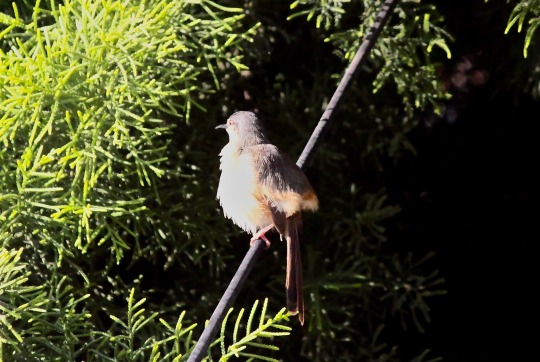



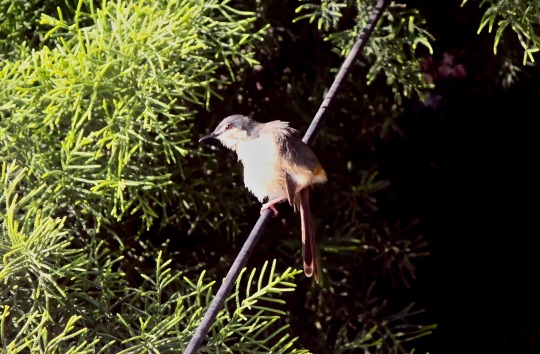



Moods,
Ashy Prinia (Ashy Wren-Warbler),
Hyderabad, 2021
2 notes
·
View notes
Photo

The ashy prinia or ashy wren-warbler is a small warbler in the family Cisticolidae. This prinia is a resident breeder in the Indian Subcontinent, ranging across most of India, Nepal, Bangladesh, Bhutan, Sri Lanka and western Myanmar . . #incredibleindia #incredible_india #nature #naturephotography #naturelovers #naturelover #nature_perfection #naturephotograpy #natureseekers #naturephotos #bird #birdsofinstagram #birds_captures #birdwatching #birding #birdextreme #birdstagram #birdshots #birds_bees_flowers_n_trees #birds_private #birdselite #birds_nature #birdspotting (at The Close, South, Nirvana Country, Gurgaon) https://www.instagram.com/p/CGopV8TnPSm/?igshid=edu1s9cpk967
#incredibleindia#incredible_india#nature#naturephotography#naturelovers#naturelover#nature_perfection#naturephotograpy#natureseekers#naturephotos#bird#birdsofinstagram#birds_captures#birdwatching#birding#birdextreme#birdstagram#birdshots#birds_bees_flowers_n_trees#birds_private#birdselite#birds_nature#birdspotting
0 notes
Photo

Cute & Chirpy Prinia 🧡 The Ashy Prinia or Ashy Wren-warbler (Prinia socialis) is a small warbler. It is a resident breeder in the Indian Subcontinent. It is a common bird in urban gardens and farmland in many parts of India and its small size, distinctive colors and upright tail make it easy to identify. They have short rounded wings and longish graduated cream tail tipped with black subterminal spots. The tail is usually held upright and the strong legs are used for clambering about and hopping on the ground. They have a short black bill. The crown is grey and the underparts are rufous in most plumages. Actively moves in the undergrowth; often flicks and erects tail; typical jerky flight when flying from bush to bush; noisy and excited when breeding. The Ashy Prinia builds its nest close to the ground in a shrub or tall grass and lays 3-5 eggs. Clicked at Sirpur Lake, Indore (Madhya Pradesh), India, on 9th June 2019, with Nikon P1000. DOP: 23.6.19 ~~~~~~ F/5.6; Exp: 1/640 sec; ISO 100; Focal Length: 234 mm; Exposure Bias: -0.7 EV; Spot Metering; On Tripod. (at Sirpur Lake) https://www.instagram.com/p/BzD89O8AW4Y/?igshid=1velduykdr51m
0 notes